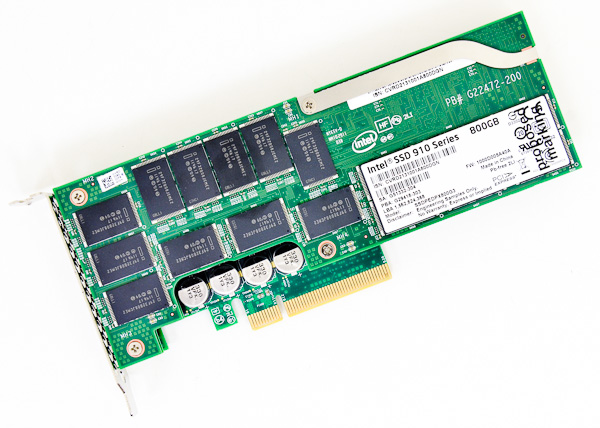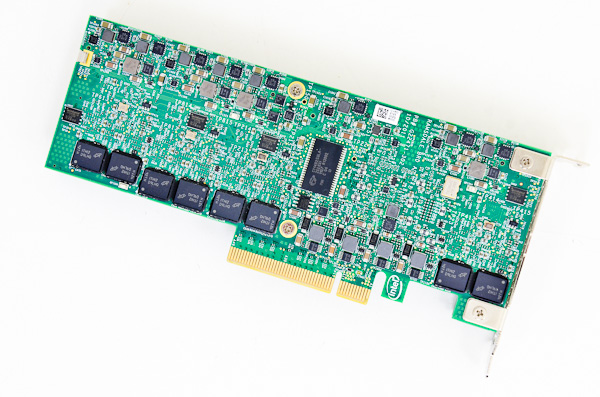The Intel SSD 910 Review
by Anand Lal Shimpi on August 9, 2012 1:00 PM EST- Posted in
- Storage
- SSDs
- Intel
- Intel SSD 910
Final Words
From a performance perspective, the Intel SSD 910 is an absolute beast. If you take into account encrypted or otherwise incompressible data performance, the 800GB 910 is easily the fastest SSD we've ever tested. The performance loss for the 400GB drive makes it a bit more normal, but it's still among the best. The only thing to be concerned about with the 910 is its poor low queue depth, small file write performance. If your workload is dominated by 2KB (or smaller) writes then the 910 isn't going to be a great performer and you'd be much better off with a standalone 2.5" drive. For all other workloads however, the 910 is great.
Pricing is also extremely competitive with other high-end enterprise PCIe offerings. Intel comes in at $5/GB for its top of the line enterprise SSD, despite the 710 being introduced at over $6 per GB. If you really want to get nostalgic, the old X25-E launched at over $15/GB. The cost per GB is much lower if you take into account how much NAND Intel is actually putting on board the 910. With 56 x 32GB 25nm MLC-HET die on a single 800GB 910, you're talking about around $2.23 per GB. I'd even be interested in seeing Intel offer a higher capacity version of the 910 with less endurance for those applications that need the performance but aren't tremendously write heavy.
Of course there's Intel's famed reliability to take into account. All of the components on the 910 are either widely used already or derived from SSDs that have been shipping for years. There's bound to be some additional firmware complexity but it's nothing compared to doing a completely new drive/controller. Most of the server shops I've worked with lately tend to prefer Intel's 2.5" SSDs, even though there are higher performing alternatives on the market today. The 910 simply gives these folks an even higher end option should their customers or workloads demand it.
My only real complaint is about the inflexibility on the volume side. It would be nice to be able to present two larger volumes (or maybe even a single full capacity volume) to the OS rather than four independent volumes on an 800GB 910. Some VM platforms don't support software RAID and at only 200GB per volume capacity could become an issue. You really need to make sure that your needs are properly lined up with the 910 before pulling the trigger.
As a secondary issue, although I appreciate the power of Intel's SSD Data Center Tool, I would like to see something a bit easier to use. Not everyone wants to grok hexadecimal temperature values (although doing so wins you cool points).
Overall I'm pleased with the 910. It's (for the most part) a solid performer, it's competitively priced and it should last for a good while. If you're space constrained and need to get a lot of local IO performance in your server, Intel's SSD 910 is worth considering.












39 Comments
View All Comments
web2dot0 - Friday, August 10, 2012 - link
That's why you need a comparison buddy. Otherwise, why don't we just read off the spec sheet and declare a winner? Let's face it z-drive r4 is NO FusionIO ok.FusionIO is a proven entity backed my a number of reputable companies (Dell, HP, etc...). Those companies didn't sign on because the cards are crap. Who's backing Z-Drive?
They are the standards in which enterprise SSDs are measured. At least, that's the general consensus.
happycamperjack - Friday, August 10, 2012 - link
Spec sheet? did you even read the benchmarks in that comparison? FusionIO's ioDrive clearly lost out there except for low queue situation.As for who's backing OCZ's enterprise SSD, let's see, Microsoft, SAP, ebay just to name a few. I don't know where you get the idea that OCZ's enterprise products do not meet the standard, but they are currently the 4th largest enterprise SSD provider. So you are either very misinformed, or just a clueless FusionIO fanboy.
web2dot0 - Sunday, August 12, 2012 - link
Come on dude.You are clearly looking at the specsheets. The feature sets offered by FusionIO cards are light years ahead of OCZ cards.
The toolset is also light years ahead. It's not always just about performance. Otherwise, everyone will be using XEN and nobody will be using VMWARE. Get it?
I would like to see a direct comparison of FusionIO cards (on workloads that enterprises matter), not what you THINK it will perform.
You are either very much misinformed or you are a clueless kid.
happycamperjack - Thursday, August 16, 2012 - link
what spreadsheet? I'm comparing the benchmark charts at later pages, which you obviously have not clicked through. There's enterprise comparisons too ok kid?what's great about FIO is its software sets for big data and its low latency and high low queue data access performance. but if just comparing single card performance per GB price ratio, FIO is overpriced IMO. And FIO's PCIe cards' lackluster performance in high queue depth is highlighting what could be the doom of FPGA PCIe cards as the cheap ATIC controllers mature and overthrow the FPGA cards with its abundant number on a board.
My guess is that in 2 years, FPGA PCIe SSDs would be used only in some specialized Tier 0 storages for high performance computing that would benefit from FPGA's feature sets. Similar to Rambus's RDRAM's fate.
And if OCZ is good enough for MS's Azure cloud, I don't see why it's not good enough for other enterprise
hmmmmmm - Saturday, August 11, 2012 - link
unfortunately, they are comparing the 910 to a 2009, discontinued card from fusion-io. would like to see a new card in the comparison to be able to compare what's on the market todayhappycamperjack - Thursday, August 16, 2012 - link
I love to see some ioDrive 2 comparisons too. Unfortunately I can't find any.zachj - Thursday, August 9, 2012 - link
Does the 910 have a capacitor to drain contents of DRAM to flash during a power outage?FunBunny2 - Thursday, August 9, 2012 - link
It looked like it, but I didn't read a mention. Could be bad eyesight.erple2 - Thursday, August 9, 2012 - link
For the market that this targets, you should never have a power outage that affects your server. These are too expensive to not have some sort of redundant power source like at least a solid ups, or better yet, a server room backup power generator.That having been said, if you look at the main PCB, you can see 4 capacitors of some sort.
mike_ - Saturday, August 11, 2012 - link
>>For the market that this targets, you should never have a power outage that affects your server.You'd wish it weren't so, but environments can and will fail. If it has capacitors and such that's great, if it doesn't this device is effectively useless. Surprised it didn't get mentioned :)